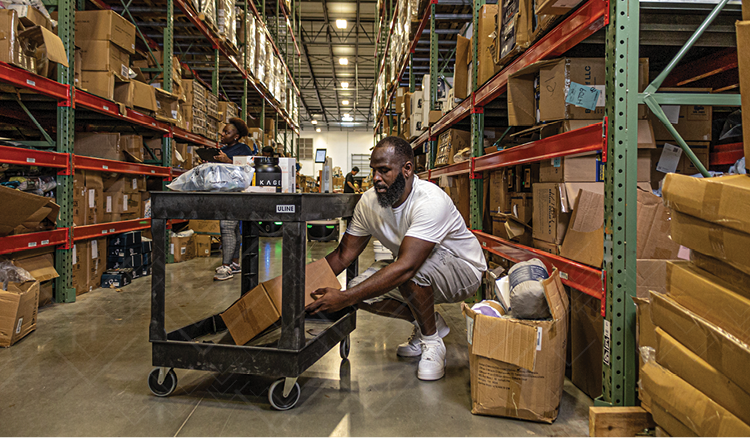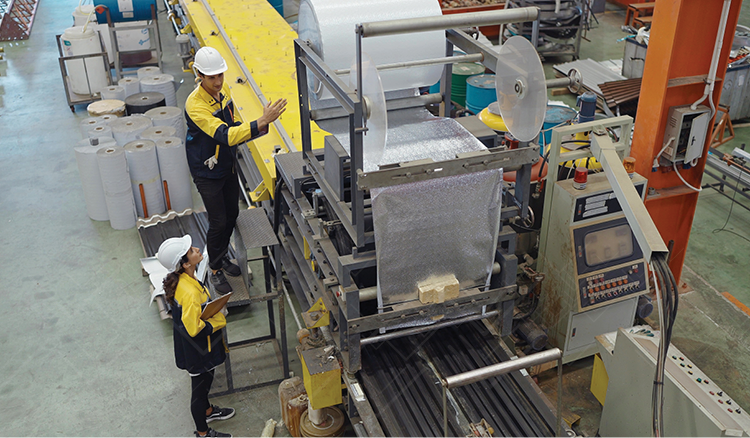Why Headcount Should Never Be a Planning Metric
In manufacturing and distribution, headcount has long been the go-to metric for capacity planning. How many people do we need? How many shifts can we run? How many orders can we fill? For decades, this model worked well enough. It was simple, straightforward, and suited to an era of steady production lines and predictable markets. Businesses hired based on quarterly or annual forecasts, staffed shifts around fixed schedules, and scaled slowly through recruitment drives or agency temps. But that era is over, and clinging to it now is like trying to navigate a storm with an outdated map.
The businesses winning today aren't asking how many people they need. They're asking how fast they can respond, how precisely they can align effort to demand, and how they can flex without compromise. They're building operations that thrive on uncertainty, turning volatility into a competitive edge. In a world of just-in-time expectations, global disruptions, and hyper-customization, rigidity is the enemy. Agility is the key to survival. Headcount planning is holding you back.
Headcount Is a Lagging Indicator
It's a relic of a time when demand was more predictable, hiring cycles were shorter, and volatility was the exception, not the rule. Back then, you could forecast quarterly needs, hire accordingly, and adjust with minimal friction. Today, demand shifts by the hour. Production goals change by the shift. Customers expect fast turnaround, low cost, and zero compromise on quality. In this world, planning around static headcount is not just ineffective—it is dangerous. It locks you into costs you can't escape, exposes you to risks you can't mitigate, and blinds you to opportunities you can't seize.
Imagine a factory floor where a sudden order surge arrives mid-shift, or a distribution center hit by a supply chain glitch overnight. With headcount as your anchor, you're stuck reacting slowly—scrambling for overtime approvals or waiting days for temps. The result? Missed deadlines, eroded margins, and frustrated customers. Meanwhile, agile competitors pivot instantly, capturing the revenue you left on the table.
Reason 1: Projections Are Always Wrong
“Forecasts are always wrong. The question is by how much and in what direction.” – Tom Wallace
Forecasting labor needs is like forecasting the weather: you're never exactly right. You build a schedule based on assumptions—historical data, sales projections, economic trends—only to have demand spike unexpectedly from a viral product trend or a key customer delay their order due to their own disruptions. And yet, entire workforce strategies are built on these shaky foundations. One study from Deloitte found that 70% of manufacturers experience significant forecast errors quarterly, leading to either bloated payrolls or chaotic scrambles.
Headcount-based planning forces you to lock in labor long before you know what you actually need. You either overstaff to play it safe and carry unnecessary cost—think idle workers during lulls eating into your margins—or you understaff and end up scrambling, falling behind, and burning out your team with last-minute fixes. In volatile sectors like consumer goods distribution, this mismatch can cost 10-15% of annual labor budgets in inefficiencies alone.
When projections fail—and they will—your options are limited. Either you absorb the hit to performance (e.g., delayed shipments eroding customer trust), or you resort to costly, reactionary solutions like overtime (which spikes premiums by 50%) or temp agencies (with their high markups and unreliable quality). According to McKinsey, over 40% of manufacturing executives report demand volatility as their number one challenge, yet many still rely on rigid forecasts that amplify the pain.
“You may not be able to predict the future, but you can build a system that adapts to it.” – Clay Christensen
With a flexible model, uncertainty becomes manageable. You respond to what’s real, not what’s projected. Tools like real-time demand signals and on-demand resources allow you to adjust instantly, turning potential crises into seamless operations. No more guessing games—just execution that keeps pace with reality.
Reason 2: Your Team May Surprise You
Headcount planning assumes every person contributes equally. But anyone who’s run a shift knows that’s not reality. A well-tuned team of 5 can outperform an average team of 8, leveraging skills, motivation, and synergy to hit targets faster and with fewer errors. A single high performer can be worth two or three warm bodies, innovating processes on the fly or mentoring others to elevate the group. Conversely, a single low performer can drag the entire crew down, creating bottlenecks, rework, and morale dips that ripple through the operation.
When you plan by headcount, you plan for averages—not outcomes. And in today’s environment, averages don’t cut it. Precision matters. You need to know who’s on the floor, what they’re capable of, and how to match them to the right job at the right time. Blind reliance on numbers ignores variables like skill levels, attendance patterns, and even daily energy—factors that can swing productivity by 20-30% in a single shift.
Veryable flips the equation. With Your Labor Pool (YLP), businesses build their own bench of vetted, rated operators who have proven their value in your specific environment. You know exactly who performs well, who works efficiently, and who adds value—backed by data from past ops, ratings, and feedback. Instead of assuming 10 people will get the job done, you deploy the 7 who consistently deliver, optimizing for quality over quantity. With Veryable WFM, this kind of planning is routine: real-time insights into operator performance let you fine-tune teams dynamically, turning surprises into strengths.
In operations, the quality of execution matters more than the quantity of effort. By focusing on capabilities rather than counts, you unlock hidden potential, reduce waste, and drive results that headcount alone could never achieve.
Reason 3: The Workforce Should Match the Workload
This is the most important shift in mindset: your workforce should flex to match the workload—not the other way around.
Fixed headcount assumes fixed demand. But demand isn’t fixed. It moves with market conditions (e.g., economic shifts or competitor moves), customer orders (sudden bulk requests or cancellations), and unforeseen disruptions (supply shortages or global events). Why should your workforce be any different? In a headcount model, you're tethered to payroll commitments that don't care about reality—leading to mismatches that erode profits and performance.
When you plan around static headcount, you're essentially forcing the work to conform to your staffing. That leads to one of two outcomes: excess capacity during slow periods, where you pay for idle labor (costing U.S. manufacturers $50B+ annually in underutilization), or insufficient capacity during surges, where backlogs grow, lead times slip by days or weeks, and customer satisfaction drops (with churn rates rising 15-20% from delays).
Veryable solves this by enabling real-time capacity. You deploy labor only when you need it, in the quantity you need, with the skills you require. No contracts tying you down. No idle time draining resources. Just execution that matches the pace of demand, whether it's ramping up for a flash sale or scaling down post-peak. This isn't just reactive; it's proactive, building resilience into your core operations.
Labor should follow the work, not the calendar. In an era of lot-size-one customization and 24/7 expectations, this flexibility isn't optional; it's essential for staying ahead.
The ability to scale with precision is what separates agile operations from rigid ones. It is what separates leaders from laggards, turning potential threats into opportunities for efficiency and innovation.
The Better Metric: Throughput
If headcount is flawed, what should you measure? The answer is throughput: the amount of product moved, orders shipped, or processes completed within a given timeframe. Throughput reflects performance, not just presence, capturing the real output of your operations, from raw materials in to finished goods out.
When you shift from headcount planning to throughput planning, you stop managing people and start managing outcomes. You focus on what matters: customer delivery (e.g., hitting 98% on-time rates), quality (reducing defects by optimizing flows), and cost (aligning expenses directly to value created). Metrics like OEE (Overall Equipment Effectiveness) or cycle time become your north star, revealing bottlenecks that headcount masks.
Veryable enables this shift by making throughput flexible. You don't have to add permanent headcount to scale—risking overcommitment in downturns. You don’t have to beg temp firms to send better people, dealing with inconsistent quality. You have a ready pool of proven operators who perform, and who are available on demand, rated for reliability and efficiency. Integrate with Veryable WFM for real-time performance tracking and planning, and watch throughput soar as you deploy precisely what's needed.
“Headcount tells you how many people are standing there. Throughput tells you what they’re actually doing.”
This isn't just a better metric—it's a transformative one, turning operations from cost centers into profit drivers.
What This Looks Like in Practice
In distribution, managers clear same-day backlogs without overtime by flexing their YLP up or down by the shift, or task with piecework pay, ensuring pallets move swiftly even during unexpected truck delays.
In manufacturing, skilled operators are deployed only when production lines spike, not staffed "just in case", allowing for seamless ramps in assembly without idle machinery or rushed quality checks.
In returns processing, warehouses adjust operator counts daily based on inbound volume, keeping costs aligned with actual demand and preventing overflow that ties up space and capital.
Veryable is powering this shift across thousands of operations. Companies like RTIC have used flexible capacity to scale headcount from 1 to hundreds during peaks, maintaining service levels and cost per unit. Core-Mark improved on-time dispatch by 10% and reduced overtime by 15% while handling 27% demand growth. The Folde boosted gross margin per order by 36% and eliminated overtime entirely. These aren't outliers—they're proof that outcome-focused planning delivers real results.
Final Thoughts
Headcount tells you how many people showed up. Throughput tells you how well your operation performs. And agility determines whether you can keep up with the next curveball, be it a market shift, a supply glitch, or a customer rush.
If you're still planning around headcount, you’re driving with the rearview mirror, reacting to yesterday's data in today's chaos. It’s time to lead with performance, building systems that adapt, scale, and excel no matter what comes.
Let Veryable help you build the execution muscle to meet any demand, any day. With YLP and WFM, you're not just surviving volatility—you're thriving in it.
Previous Posts
How Policy Constraints, Not Just Production Bottlenecks, Threaten Your Bottom Line
The Future of Manufacturing and Logistics
Create a free business profile today to explore our platform.






